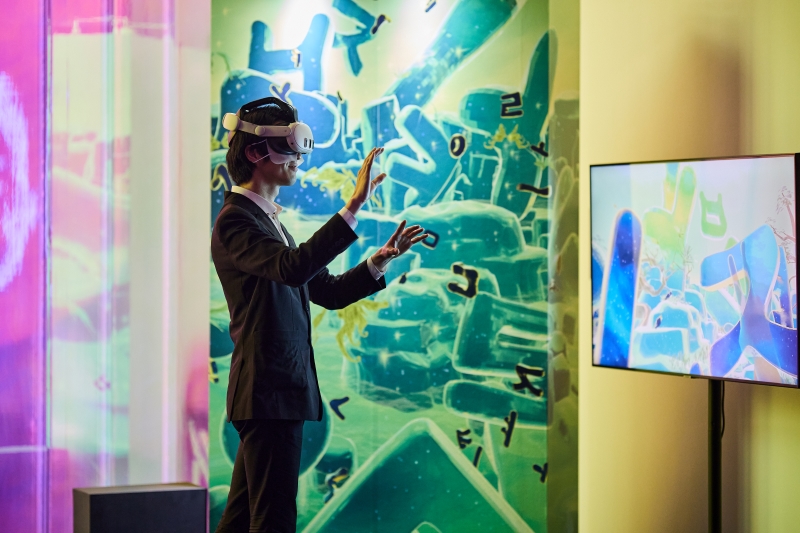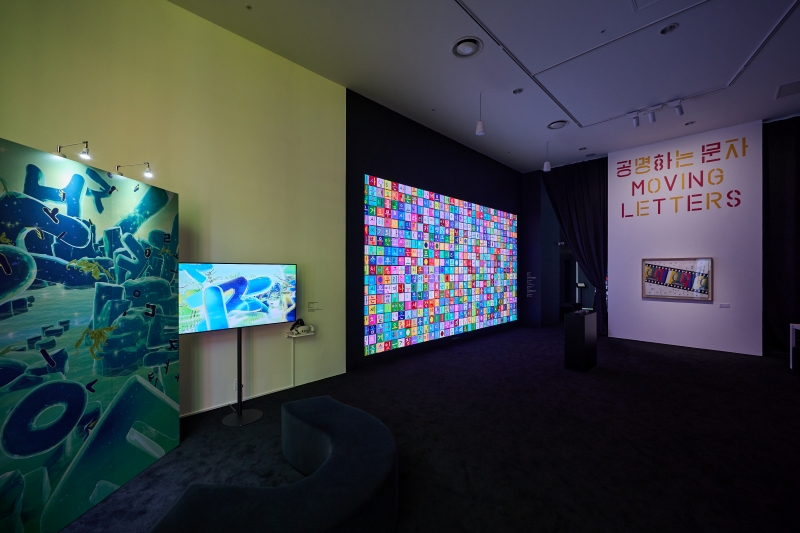[INTERVIEW] ‘’Hangeul Garden’’ by Hwia Kim, presented as part of the ‘’Moving Letters’’ exhibition
2025-05-07The KF (Korea Foundation) XR Gallery, Seoul, is holding an exhibition titled “Moving Letters” from March 31 to September 21, 2025, commemorating the 80th anniversary of Korea’s liberation and celebrating the cultural significance of Hangeul, the Korean alphabet. “Moving Letters” brought together artists who reimagined Hangeul in creative ways using technologies such as virtual reality, augmented reality, and immersive digital storytelling. One of the artists featured in the exhibition is Hwia Kim, with her installation “Hangeul Garden,” which presents the Korean alphabet through virtual reality.
Hwia Kim is a contemporary Korean media artist whose work investigates the intersection of technology and art, utilizing mediums such as virtual reality, deep learning, and robotics. She earned a Bachelor’s degree in Fine Arts (sculpture) from Hongik University and a Master’s degree in Fine Arts (intermedia) from the Korea National Art College in Seoul.
She participated in exhibitions such as “Creatives in Motion” at the Korean Cultural Center in New York (2025), “Future Scenery: Art Korea Lab Festival” held at Art Korea Lab in Seoul (2024), “Unbinding Bodies” at Gallery 99 in Seoul (2024), and “Limbo Dance: Ways of Passing Between Earth and Objects” at Daegu Art Factory in Seoul (2023).
I was particularly drawn to Hwia Kim's green world in "Hangul Garden," a VR installation where visitors engage with the rounded Hangeul letters.
Below are excerpts from an email interview with Hwia Kim from April 29 to May 2.
1. What influenced the creation of "Hangeul Garden"?
"Hangeul Garden" was inspired by the garden of my parents-in-law, who are Dutch and live in the Netherlands. My mother-in-law, who often misses us living far away, used to study Hangeul on her own. Every time I visited, I was touched to see her notebooks filled with carefully handwritten Hangeul characters. I created this work to preserve those dreamlike memories of early summer days spent studying Hangeul together in their garden.
2. Why did you choose a garden as the setting for expressing the essence of Hangeul?
In the Dutch village where my in-laws live, most homes have gardens. For someone like me, living in the heart of Seoul, that felt quite special. Each garden has its own personality, shaped by the person who tends it. For example, my in-laws’ garden has many birds, a small apple tree, and a quiet little pond, and it’s always lovingly cared for. I see Hangeul in a similar way. Its beauty and meaning evolve depending on how it’s used and cared for. That’s why a garden felt like the perfect space to express what Hangeul means to me.

3. What steps were involved in developing the visual and interactive elements of the VR environment?
The VR environment was built using Unity. Since it's a virtual garden, I wanted to evoke a more cosmic atmosphere. Through material design, I aimed for a surreal and fantastical mood, and added butterflies and birds flying freely, rendered in dreamy colors. I also placed the participant underwater, rather than standing on solid ground, to enhance a sense of closeness with nature. For interaction, I used hand-tracking technology, allowing users to interact with floating Hangeul objects using their own hands.
4. What is the significance of the shapes and colors of Hangeul in your installation?
In my imagination, letters are always in motion. They are not just geometric lines; they carry meaning and float around us. Each Hangeul character is reinterpreted based on the movement I felt in that moment, given a soft, rounded shape, and animated. The endlessly squirming and wriggling Hangeul objects aim to show that Hangeul is not fixed; it is, quite literally, a "moving letter" and a “living letter.”
5. We’d love to hear a few words about the "Hangeul Garden" Virtual Reality experience.
The "Hangeul Garden" VR experience has no fixed play time and can be explored freely. As mentioned, using hand-tracking technology, users can grab and rearrange floating Hangeul objects to form their own words. One of the things I find magical about Hangeul is how its shapes transform, if you turn ‘ㅗ’ sideways, it becomes ‘ㅓ’ or ‘ㅏ’; if you flip it, it becomes ‘ㅜ’; adding ‘ㅣ’ can turn it into ‘ㅔ’ or ‘ㅐ’. By playing with the letters in space, I hope visitors discover new ways to see and feel the visual and structural beauty of Hangeul.

6. What influence do you think the "Moving Letters" exhibition and your work will have on the visitors?
The "Moving Letters" exhibition reveals the many intricate pathways through which Hangeul connects us to the world. Hangeul used to be written with a brush and ink on hanji, printed in tightly bound books, or practiced over and over in notebooks, and now, as pixelated data permeating digital space, it reaches people on the other side of the globe. Is there anything more expressive of our desire to connect than “letters”?
7. What are your hopes for how international audiences engage with Korean language and culture through works like yours?
My work is quite ordinary. It’s simply an expression of love and happiness with my family. It holds the memory of laughing with my parents-in-law while feeding birds in the garden. I hope audiences experience "Hangeul Garden" with a sense of warmth and come away feeling that Korean language and culture can emerge not only from grand narratives of “K-culture,” but also from something deeply personal and familial.
Through "Hangeul Garden," Hwia Kim beautifully merges personal memories with her Korean roots, inviting us to explore Hangeul not just as the Korean alphabet, but as a ''living letter.''
How about this article?
- Like0
- Support1
- Amazing0
- Sad0
- Curious0
- Insightful0


